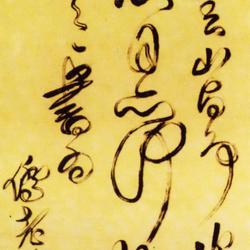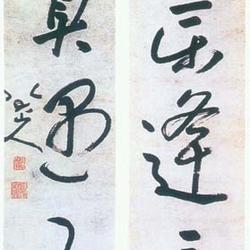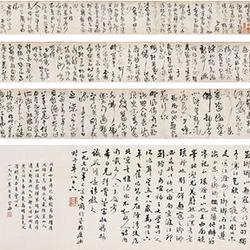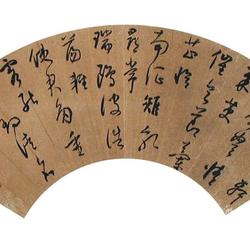Explanation: During the Taiyuan period of the Jin Dynasty, the people of Wuling were engaged in fishing. Walking along the stream, forgetting the distance of the road, I suddenly encountered a peach blossom forest, hundreds of steps along the bank. There were no trees in the middle, the grass was delicious, and the fallen flowers were colorful. Fishermen are very different. Going forward again, I want to exhaust the forest. When the forest runs out of water, there is a mountain. There is a small opening in the mountain, as if there is light. Then he left the boat and entered through the mouth. Repeat dozens of steps, feeling enlightened. The land is vast, the houses are scattered, and there are fertile fields, beautiful ponds, mulberry trees, and bamboos. There is traffic on the streets, and chickens and dogs hear each other. Among them, the men and women are dressed like outsiders. His yellow hair hangs down, and he is contented with himself. When he saw this person, he was shocked. He asked where he came from and gave him an answer. Then he returned home, where he set up wine and killed chickens for food. Hearing about this person in the village, Cheng came to inquire. Since the ancestors of Yun Dynasty fled the Qin Dynasty, they came to this desperate situation with their wives and people. They never came out, so they separated themselves from outsiders. When I ask what era this is, I don’t know whether there was the Han Dynasty or the Wei and Jin Dynasties. This person was saddened by everything he said and heard. The rest of the people went to their homes again, where they all had wine and food. Stop for a few days and resign. One of the people said: "It's not enough to teach outsiders." After getting out and getting the boat, he helped him to the road and looked for it everywhere. Naijun, the prefect, said so. The prefect immediately sent people to follow him in search of his desired direction, but he became lost and could no longer find his way. Liu Ziji from Nanyang was a noble scholar. Hearing it, he looked up happily. Without success, he ends up seeking illness. So no one cared. Ying's family is in chaos, and wise men avoid it. Huang Qi's Qi Shan, the beauty also passed away. The traces of the past are lost and forgotten, and the paths of the past are in ruins. Xiang ordered people to farm, and the Japanese people stayed there. The mulberry and bamboo trees are hanging down in the shade, the bean sprouts are harvested at any time, silkworms are harvesting filaments in the spring, and the king's tax is paid when they are ripe in the autumn. The deserted road warms traffic, and chickens and dogs bark at each other. Zu Dou is still an ancient method, and clothes cannot be used to control it. Children and children are singing songs, and their gray hair is watching the journey. The grass is strong and harmonious, and the wood is decaying and the wind is strong. Although there is no calendar, the four seasons form their own years. I am happy and happy, so why bother with wisdom: the strange trace has been hidden for five hundred times, and once it was revealed to the world of gods. Simple and thin, it has a different origin, and it is also secluded when it comes back. I would like to ask the traveling alchemist, how can I judge what is happening outside the hustle and bustle of the city~? I would like to whisper in the breeze and hold it high to find my contract. Qianlong Jiashen Dongyuelu. Huang Shen.
Appendix: Introduction to "Huang Shen's Cursive Script of Peach Blossom Spring"
Huang Shen (1687-1772), also known as Gongmao, also known as Gongshou, also known as Yinglaozi, Donghai Buyi, Qi Min Old Painter, etc. A native of Ninghua, Fujian, he has been a commoner all his life. During Yongzheng's reign, he moved to Yangzhou.
Huang Shen was born in a poor family with half-farming and half-education. His father, Huang Jusheng, was a scholar. In order to make a living, he moved to a foreign land and died in Dongting. Shen read his father's books at home since he was a child. When his father died, he served his mother. Since he had no career, he lived in Xiaosi when he was eighty-nine years old. He determined to learn painting to support his family and read and practiced painting every night. In the 14th and 5th year of his life, he gave up his career and learned portraiture, meticulous painting of flowers and birds, landscapes and towers from Tongli painter Shangguan Zhou. After a little while, I realized that "it is difficult for my teacher to compete for fame with his unique skills. A man with lofty ideals should become famous on his own, how can he be willing to be second to others?" Later, I occasionally saw Huaisu's original work. After repeated speculations, I was inspired by it. I then imitated Zhang Changshi's allusions about Sun Gong's dancing with swords and watching the bearers fighting for the road. He created his own artistic style as he swayed his character. The characters he wrote were mostly based on historical myths and stories, the lives of literati and husbands, and images of lower-class working people such as fishermen, trackers, wanderers, and beggars. The lines of the clothing lines are sparse and wild, and the changes are endless. A few strokes use simplicity to control the complexity, and the form and spirit are both vivid and lifelike. Although the landscapes are based on Ni Huang's and Zhonggui's paintings, the writing style is vertical and horizontal and the atmosphere is majestic. The flower and bird works also have a natural meaning. Shangguan Zhou Jianzhi praised him highly as "after Youjun, there is Lu Gong", but Huang Shen was not satisfied with this, but kept in mind his mother's teachings: "A son does what is right, and a good man has no choice. However, I heard that this is not the case." Study poetry and calligraphy, have the charm of a scholar, and have an ear for every painting and skill." He strives to pursue the realm of what the poet Zhang Qin said: "There are paintings in poems, and there are poems in paintings." He devoted himself to studying poetry, and finally made his poetry and painting famous. His poems were collected and compiled into four volumes of "Jiaohu Poetry Notes" by fellow countryman Lei Hong. Then he worked hard on calligraphy, earning the reputation of "the three greatest talents in poetry, calligraphy and painting" and becoming famous all over the country. After reading thousands of books and traveling thousands of miles, Huang Shen decided to leave home and travel to Yuzhang, Wuyue and other places to broaden his horizons. In his middle age, in order to facilitate the sale of paintings, he moved to Yangzhou with his mother in the fifty-eighth year of Kangxi (1719) when he was thirty-six years old. He became friends with celebrities for a while and became close friends with Zheng Xie and Li Wei. He was listed as one of the "Eight Eight Painters of Yangzhou". One of the "weirds" and very popular in society.
Infected by the innovative artistic atmosphere in Yangzhou, Huang Shen began another attempt at reforming the art of calligraphy. He abandoned regular script and made cursive script, abandoned Zhong Yao and followed the example of the two kings. He learned from Huai Su from far away and from Ming Dynasty by staying close to him. He also incorporated the advantages of painting into The key points of calligraphy are unique in the traditional cursive calligraphy style. The lines are discontinuous and clever. The rest of the strokes are stored in the fonts and strokes. The white is white and the black is black. The sparse and dense are alternated. They are natural and natural, forming a distinctive and unique style. A pattern of wild cursive has caused a sensation in the entire Yangzhou calligraphy world with its brand-new artistic outlook. From then on, he became one of the literati painters and became an art giant in the Qing Dynasty. The painters spent a lot of money to buy it, and it became a treasure on the wall. For example, the hand scroll "Peach Blossom Spring Painting and Calligraphy", as one of his masterpieces in his later years, was collected by many famous artists and eventually became a valuable asset in the national collection.
Huang Shen's "Peach Blossom Spring Painting and Calligraphy" hand scroll, paper, color, 38 cm in length, painted in Jiashen (1764), the 29th year of Qianlong's reign in the Qing Dynasty, when the author was seventy-seven years old. Wu Changshuo (1844-1927), a famous maritime figure, wrote the first volume at the age of seventy-one.
The cursive script excerpts from Tao poetry and self-written five-character poems attached to the pictures are resolutely contrary to the continuous linear brushwork of traditional cursive calligraphy. Instead, the creative ideas are exciting and vibrant ink dots, and the introduction of lyrical painting is used to give full play to one's superb skills. With his painting skills, he integrates his experience in dealing with voids and solids in layout and arranging density of landscaping into calligraphy chapters. The vigorous brush strokes like a cone to draw sand and a hairpin to fold vertically and horizontally, with sudden twists and turns, the meaning is connected with the brush strokes, which is superb. Suddenly it resembles the poem written by Zhong Yao of the Wei and Jin Dynasties, with grass dancing in the white rain, and rabbits rising and falcons falling; suddenly it resembles Huai Su's poem of the Tang Dynasty, with the withered vines hanging in the air, the luan dancing and the snake frightened. Both calligraphy and painting, the rhythm is strong, the atmosphere is majestic, and it is shocking. Just like Qian Meishou's poem "Inscribed on the yellow gall gourd to be careful of the barriers in the mountains and rivers": "Suddenly sparse, suddenly dense, smoke and clouds appear from the fingertips in the sky. Suddenly withered, suddenly born, the wind and rain in the forest are all filled with the sound of autumn. A stick of pen, a stroke of ink, and excitement The pen jumps and the ink moves. The pen is full of spirit, the ink leaves no trace, and the mountains and rivers are full of snakes and dragons. It is not a disease not to follow the rules, but it is his nature to not be restrained." It is also suitable to describe Huang Shen's writing style.
Huang Shen's calligraphy was highly praised by his contemporaries for his paintings-like calligraphy and paintings. For example, Taoist Qingliang once said in "Tingyuxuan Notes" that "his calligraphy is exactly like his paintings vertically and horizontally." Lei Hong also praised in the "Preface to Jiaohu Poetry Notes": "The characters are like sparse shadows and tangled vines, but they are called mountain people. There can be paintings in the poems, and there can be paintings in the words." The origin of calligraphy and painting is that The soul of ancient Chinese literati paintings, Huang Shen, with his diligent practice, closely integrated the charm of traditional poetry, calligraphy and painting, and set up a dazzling banner in the art world of the mid-Qing Dynasty.



















